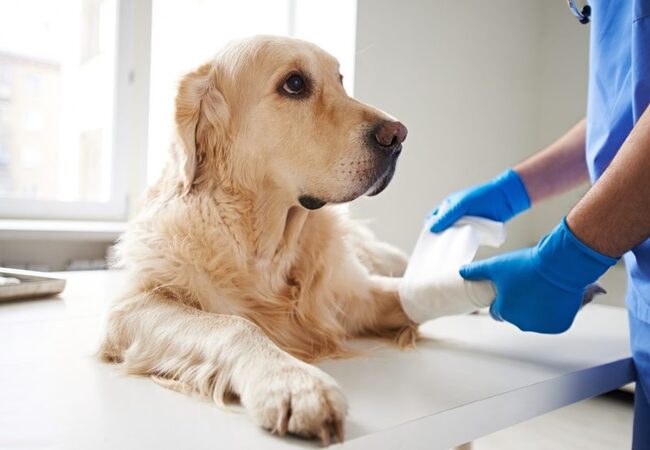Torn Knee Ligament in Dogs in 2025 Vet Guide: Treatment, Rehab & Recovery 🦵🐾

In this article
Torn Knee Ligament in Dogs in 2025 Vet Guide: Treatment, Rehab & Recovery 🦵🐾
By Dr. Duncan Houston BVSc
Hello, attentive pet parents! I’m Dr Duncan Houston BVSc. In this comprehensive 2025 guide, we’ll explore torn knee ligaments in dogs, commonly the cranial cruciate ligament (CCL). Learn how to identify signs, understand causes, compare treatments (surgery vs conservative), and boost recovery with tools from Ask A Vet,❤️.
1. What Is a Torn Knee Ligament?
The most frequent culprit is the cranial cruciate ligament (CCL), analogous to the ACL in humans. It stabilizes the knee (stifle) joint, preventing the tibia from sliding forward under the femur.
2. Common Causes & Predispositions
- Degenerative wear: Chronic stress weakens the ligament over time—known as cruciate ligament disease.
- Acute trauma: Sudden twists—during rough play or slipping—can provoke tear.
- Breed & weight: Common in larger breeds (Labs, Rottweilers, Newfoundlands) and overweight dogs; middle age (6–8 yrs) is peak risk.
3. Signs & Symptoms 🩺
- Hind-leg lameness—ranging from mild to non-weight bearing.
- Swollen or painful knee upon manipulation.
- “Drawer sign”: abnormal forward movement of the tibia.
- Difficulty standing, jumping, or climbing stairs.
4. Diagnosis 🔍
- Physical exam & gait evaluation.
- Drawer test and tibial compression test under sedation if needed.
- X-rays to rule out fractures and assess arthritis.
- Advanced imaging (CT, MRI, ultrasound) in athletic or complex cases.
5. Treatment Options in 2025
a) Surgical Stabilization
Surgery offers the best long-term outcomes for most dogs >15 kg: TPLO, TTA, or extracapsular repairs.
- TPLO: Cuts and repositions tibia, reducing ligament needs. Stable, high success (>90%).
- TTA: Advances tibial tuberosity for joint stabilization.
- Extracapsular sutures (e.g., Tightrope CCL): Uses artificial bands outside the joint; effective in small to medium dogs.
b) Non‑Surgical (Conservative) Management
May suit small dogs (<15 kg) or those unsuitable for surgery. Includes:
- Restricted activity + weight management.
- NSAIDs, joint supplements (glucosamine, chrondroitin), Adequan.
- Knee braces—or braces with rehab.
- Physical therapy to build muscle and range of motion.
50–90% of dogs improve conservatively at 1 year versus higher success with surgery.
6. Post‑Op & Rehab Protocol
- Strict leash rest for 6–12 weeks—no running/jumping.
- Progressive physiotherapy: range-of-motion, balance, underwater treadmill.
- Pain control with NSAIDs, gabapentin; joint supplements continue.
- Regular rechecks and X-rays to ensure proper healing.
7. Prognosis & Long‑Term Outlook
- Surgical success in ~85–90%, with return to function.
- Arthritis still develops but slower post-surgery.
- Conservatively managed dogs: 47–68% success at 1 year.
- Contralateral injury risk is high—up to 40–50% will tear the other knee.
8. Recovery & Home Care 🏡
- Maintain weight under control.
- Manage pain—never skip doses of prescribed meds.
- Continue joint support: supplements & low-impact exercise.
- Supervise all activity, avoid slippery surfaces.
- Regular check-ups with vet or rehab therapist.
9. Supporting Tools from Ask A Vet,
- Ask A Vet: 24/7 guidance—help with pain signs, exercise compliance, and vet visits planning.
10. Preventing Future Injury
- Maintain healthy weight and muscle tone.
- Avoid sudden leaps/jumps—especially from heights.
- Provide joint-friendly surfaces (rugs, non-slip mats).
- Regular vet evaluations for early lameness or instability.
- Consider early intervention—physical therapy can delay or prevent tears.
11. Emotional Support for Families ❤️
A torn ligament diagnosis is stressful—but you're not alone. Ask A Vet offers emotional reassurance through tough decision making. supply tools that simplify caring—letting you focus on love and recovery. Reach out to fellow pet parents and rehab communities for encouragement and shared wisdom.
12. Final Thoughts
Torn knee ligaments (CCL tear) are common yet treatable. With prompt action—whether surgical or conservative—combined with structured rehabilitation, most dogs regain mobility and quality of life. Embrace a recovery plan tailored to your pup, supported by Ask A Vet. Together, you can rebuild strength and joy step by step 🐾✨.
— Dr Duncan Houston BVSc
For ongoing guidance, visit AskAVet.com and download the Ask A Vet app today to support your pup’s healing journey!






